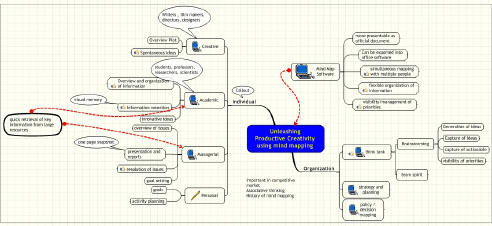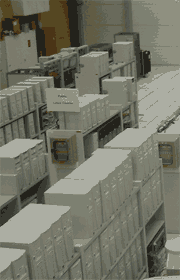Austhink: Critical Thinking Argument Mapping
BrainMine
Buzan's iMindMapô
Cayra
ConceptDraw MINDMAP
FreeMind
FreeMind
HeadCase
HeadCase
Inspiration
Map it!
Mind Pad
MindApp
MindChart
MindGenius
MindManager
MindMapper
Mindmapping, concept mapping
in 3D
MindJet MindManager Review
Unleash Productive Creativity through Mind-mapping, Part IHigh productivity is often associated with low creativity. The thumb rule is
that the more productive you try to be, the less likely you are to pay attention
to aspects like creativity and innovation. On the other hand, creative activity
often does not end in any productive results.
Given the growing need for being productive without losing sight of creativity and vice versa, the concept of productive creativity is now gaining coinage. This is creativity that is focused and organized, a product of group thinking which comes with terms like accountability and follow-up attached to it. Such creativity results in concretized products or strategies; creative ideas become productive due to an effective idea-capturing mechanism and methodical execution of the ideas captured. One of the ways in which productive creativity can be encouraged is through mind-mapping. It is a method developed by Tony Buzan which follows the brainís tendency for organic, pictorial and associative thinking. Whereas a computer works in a linear manner, the human brain works associatively and compares, integrates and synthesizes words and images at the same time. During mind-mapping, the main concept or problem is placed at the centre of the paper, and thoughts and ideas jumping out of it are compressed into words and images, and placed radially around it. This branching out goes on till all the ideas and options have been captured on paper. This process allows spontaneous thoughts and ideas to be transferred on paper without losing their freshness and immediacy, and the resulting diagram is called a mind-map. Mind-mapping can then be simply defined as associating, comparing, integrating and synthesizing words and images at the same time on a focused subject. It is all about mapping the mind on paper. Mind-maps can be very useful for individuals and organizations in order to achieve a synergy between productivity and creativity. For individuals in creative professions or roles requiring organizing skills, mind-mapping can be an efficient tool that encourages creativity, without losing sight of the end result. Writers, designers (pdf guide), directors and film-makers can have a quick overview of their projects on a mind-map which will keep them organized, focused and productive all the time. Not only that, a mind-map provides a fertile ground for new ideas to crop up through the process of associative thinking. For those in the academic professions like students, teachers, professors, scientists and researchers, mind-mapping can be a way to efficiently organize information. They can absorb it with the added help of visual memory, express it clearly and come out with new ideas after synthesizing the information on a mind map. Managers may also find it useful to keep track of the various goals, activities, and difficult issues on mind-maps, and contribute creative and productive solutions. What is more, a managerís productive creativity would show up in talks, presentations and reports. This is because a mind-map covers barely a page, but can contain all the reference information in a snapshot, including association between various topics for a talk or presentation. Choosing a project team is also fast and easy with mind-mapping. Whether you are into management or academics, you need to extend your knowledge in order to boost productivity while retaining the creative spark. Summarizing a book or an article into a mind-map helps you retain what you read, and makes the material easy to revisit. This leads to quick and associative retrieval of relevant information from a large pool of resources. For example, this article itself can be produced as a mind-map:  Mind-map of this article made on Mindjet software (click for larger image) Page 2 >> |
